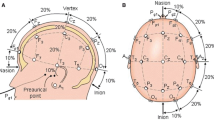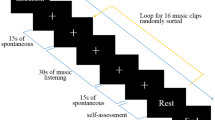Abstract
Common electroencephalograph (EEG) features have problems such as poor intrinsic correlation between characteristic quantities, low signal reproducibility and large data storage capacity, which lead to poor emotion recognition. To solve this problem, this paper proposes an EEG music model based on a musical staff. Firstly, this paper constructs a multi-channel EEG sensor network to measure the EEG of an individual under different emotional states, and establishes an EEG-Emotion mapping library for the individual. Then, the EEG is transformed by adaptive segmentation of the time-domain EEG signal using a musical staff model. The time-frequency characteristics of EEG, such as amplitude, contour and signal frequency, are expressed quantitatively in a standardized musical space. The results show that, while retaining the time-frequency features of EEG, the model has an average similarity of 0.9769 before and after reconstruction, a compression rate of 57.18%, and an emotional state recognition rate that is 10.1% higher than traditional features. The brain wave music generated by the model, as a media, provides reference for people to understand the change of emotional state, and also provides a new technical idea for the subsequent use of EEG music for emotional induction.







Similar content being viewed by others
Data availability
The datasets used and/or analyzed during the current study are available from the corresponding author on reasonable request.
References
Aldridge A, Barnes E, Bethel CL, Carruth DW, Kocturova M, Pleva M, Juhar J, Ieee (2019) Accessible Electroencephalograms (EEGs): A Comparative Review with OpenBCI's Ultracortex Mark IV Headset. 2019 29th International Conference Radioelektronika. https://doi.org/10.1109/radioelek.2019.8733482
Allman JM, Hakeem A, Erwin JM, Nimchinsky E, Hof P (2001) The anterior cingulate cortex - the evolution of an interface between emotion and cognition. In: Unity of knowledge: the convergence of natural and human science, vol 935. Annals of the New York Academy of Sciences. New York Acad Sciences, New York, pp 107–117. https://doi.org/10.1111/j.1749-6632.2001.tb03476.x
Al-Salman W, Li Y, Wen P (2019) K-complexes detection in EEG signals using fractal and frequency features coupled with an ensemble classification model. Neuroscience 422:119–133. https://doi.org/10.1016/j.neuroscience.2019.10.034
Anaya B, Vallorani A, Perez-Edgar K (2021) Dyadic behavioral synchrony between behaviorally inhibited and non-inhibited peers is associated with concordance in EEG frontal alpha asymmetry and Delta-Beta coupling. Biol Psychol 159:108018–108018. https://doi.org/10.1016/j.biopsycho.2021.108018
Bablani A, Edla DR, Kuppili V, Ramesh D (2020) A multi stage EEG data classification using k-means and feed forward neural network. Clin Epidemiol Glob Health 8(3):718–724. https://doi.org/10.1016/j.cegh.2020.01.008
Bai JJ, Luo K, Peng J, Shi JL, Wu Y, Feng LX, Li JQ, Wang YX (2017) Music Emotions Recognition by Cognitive Classification Methodologies. 2017 Ieee 16th international conference on cognitive informatics & cognitive computing. Ieee, New York
Balasubramanian G, Kanagasabai A, Mohan J, Seshadri NPG (2018) Music induced emotion using wavelet packet decomposition-an EEG study. Biomed Signal Process Control 42:115–128. https://doi.org/10.1016/j.bspc.2018.01.015
Blanchette I (2006) The effect of emotion on interpretation and logic in a conditional reasoning task. Mem Cogn 34(5):1112–1125. https://doi.org/10.3758/bf03193257
Cai HS, Han JS, Chen YF, Sha XC, Wang ZY, Hu B, Yang J, Feng L, Ding ZJ, Chen YQ, Gutknecht J (2018) A pervasive approach to EEG-based depression detection. Complexity 2018:1–13. https://doi.org/10.1155/2018/5238028
Cegar DD, Barreda-Angeles M, Kukolj D, Le Callet P (2020) Modelling effects of S3D visual discomfort in human emotional state using data mining techniques. Multimed Tools Appl 79(27–28):19803–19829. https://doi.org/10.1007/s11042-020-08844-3
Choi S, Jiang Z (2008) Comparison of envelope extraction algorithms for cardiac sound signal segmentation. Expert Syst Appl 34(2):1056–1069. https://doi.org/10.1016/j.eswa.2006.12.015
Davidson RJ (2004) What does the prefrontal cortex "do" in affect: perspectives on frontal EEG asymmetry research. Biol Psychol 67(1–2):219–233. https://doi.org/10.1016/j.biopsycho.2004.03.008
Davidson RJ, Jackson DC, Kalin NH (2000) Emotion, plasticity, context, and regulation: perspectives from affective neuroscience. Psychol Bull 126(6):890–909. https://doi.org/10.1037//0033-2909.126.6.890
Delorme A, Makeig S (2004) EEGLAB: an open source toolbox for analysis of single-trial EEG dynamics including independent component analysis. J Neurosci Methods 134(1):9–21. https://doi.org/10.1016/j.jneumeth.2003.10.009
Fdez J, Guttenberg N, Witkowski O, Pasquali A (2021) Cross-subject EEG-based emotion recognition through neural networks with stratified normalization. Front Neurosci 15:626277–626277. https://doi.org/10.3389/fnins.2021.626277
Geethanjali B, Adalarasu K, Jagannath M, Scshadri NPG (2019) Music-induced brain functional connectivity using EEG sensors: a study on Indian music. IEEE Sensors J 19(4):1499–1507. https://doi.org/10.1109/jsen.2018.2873402
Hamada M, Zaidan BB, Zaidan AA (2018) A systematic review for human EEG brain signals based emotion classification, feature extraction, brain condition, group comparison. J Med Syst 42(9):25. https://doi.org/10.1007/s10916-018-1020-8
Herrington JD, Mohanty A, Koven NS, Fisher JE, Stewart JL, Banich MT, Webb AG, Miller GA, Heller W (2005) Emotion-modulated performance and activity in left dorsolateral prefrontal cortex. Emotion 5(2):200–207. https://doi.org/10.1037/1528-3542.5.2.200
Jatupaiboon N, Pan-ngum S, Israsena P (2013) Real-time EEG-based happiness detection system. Sci World J 2013:1–12. https://doi.org/10.1155/2013/618649
Jie X, Rui C, Li L (2014) Emotion recognition based on the sample entropy of EEG. Bio-Med Mater Eng 24(1):1185–1192. https://doi.org/10.3233/bme-130919
Jirayucharoensak S, Pan-Ngum S, Israsena P (2014) EEG-based emotion recognition using deep learning network with principal component based covariate shift adaptation. Sci World J 2014:1–10. https://doi.org/10.1155/2014/627892
Katsigiannis S, Ramzan N (2018) DREAMER: a database for emotion recognition through EEG and ECG signals from wireless low-cost off-the-shelf devices. IEEE J Biomed Health Inform 22(1):98–107. https://doi.org/10.1109/jbhi.2017.2688239
Khezri M, Firoozabadi M, Sharafat AR (2015) Reliable emotion recognition system based on dynamic adaptive fusion of forehead biopotentials and physiological signals. Comput Methods Prog Biomed 122(2):149–164. https://doi.org/10.1016/j.cmpb.2015.07.006
Khosrowabadi R, Quek C, Ang KK, Wahab A (2014) ERNN: a biologically inspired feedforward neural network to discriminate emotion from EEG signal. IEEE Trans Neural Netw Learn Syst 25(3):609–620. https://doi.org/10.1109/tnnls.2013.2280271
Koelsch S (2014) Brain correlates of music-evoked emotions. Nat Rev Neurosci 15(3):170–180. https://doi.org/10.1038/nrn3666
Koelstra S, Muhl C, Soleymani M, Lee JS, Yazdani A, Ebrahimi T, Pun T, Nijholt A, Patras I (2012) DEAP: a database for emotion analysis using physiological signals. IEEE Trans Affect Comput 3(1):18–31. https://doi.org/10.1109/t-affc.2011.15
Kong R, Li JW, Orban C, Sabuncu MR, Liu HS, Schaefer A, Sun NB, Zuo XN, Holmes AJ, Eickhoff SB, Yeo BTT (2019) Spatial topography of individual-specific cortical networks predicts human cognition, personality, and emotion. Cereb Cortex 29(6):2533–2551. https://doi.org/10.1093/cercor/bhy123
Kumar HIK, Harish BS, Darshan IIK (2019) Sentiment analysis on IMDb movie reviews using hybrid feature extraction method. Int J Interact Multimed Artif Intell 5(5):109–114. https://doi.org/10.9781/ijimai.2018.12.005
Light SN, Coan JA, Zahn-Waxler C, Frye C, Goldsmith HH, Davidson RJ (2009) Empathy is associated with dynamic change in prefrontal brain electrical activity during positive emotion in children. Child Dev 80(4):1210–1231. https://doi.org/10.1111/j.1467-8624.2009.01326.x
Lin YP, Wang CH, Jung TP, Wu TL, Jeng SK, Duann JR, Chen JH (2010) EEG-based emotion recognition in music listening. IEEE Trans Biomed Eng 57(7):1798–1806. https://doi.org/10.1109/tbme.2010.2048568
Liu YJ, Yu MJ, Zhao GZ, Song JJ, Ge Y, Shi YC (2018) Real-time movie-induced discrete emotion recognition from EEG signals. IEEE Trans Affect Comput 9(4):550–562. https://doi.org/10.1109/taffc.2017.2660485
Moharreri S, Dabanloo NJ, Maghooli K (2018) Modeling the 2D space of emotions based on the poincare plot of heart rate variability signal. Biocybern Biomed Eng 38(4):794–809. https://doi.org/10.1016/j.bbe.2018.07.001
Momennezhad A (2018) EEG-based emotion recognition utilizing wavelet coefficients. Multimed Tools Appl 77(20):27089–27106. https://doi.org/10.1007/s11042-018-5906-8
Naji M, Firoozabadi M, Azadfallah P (2015) Emotion classification during music listening from forehead biosignals. Signal Image Video Process 9(6):1365–1375. https://doi.org/10.1007/s11760-013-0591-6
Nawaz R, Cheah KH, Nisar H, Yap VV (2020) Comparison of different feature extraction methods for EEG-based emotion recognition. Biocybern Biomed Eng 40(3):910–926. https://doi.org/10.1016/j.bbe.2020.04.005
Nguyen B, Nguyen D, Ma WL, Tran D, Ieee (2017) Wavelet transform and adaptive arithmetic coding techniques for EEG lossy compression. In: 2017 International Joint Conference on Neural Networks. IEEE International Joint Conference on Neural Networks (IJCNN). Ieee, New York, pp 3153–3160
Petrantonakis PC, Hadjileontiadis LJ (2010) Emotion recognition from EEG using higher order crossings. IEEE Trans Inf Technol Biomed 14(2):186–197. https://doi.org/10.1109/titb.2009.2034649
Picard RW, Vyzas E, Healey J (2001) Toward machine emotional intelligence: analysis of affective physiological state. IEEE Trans Pattern Anal Mach Intell 23(10):1175–1191. https://doi.org/10.1109/34.954607
Raheel A, Anwar SM, Majid M (2019) Emotion recognition in response to traditional and tactile enhanced multimedia using electroencephalography. Multimed Tools Appl 78(10):13971–13985. https://doi.org/10.1007/s11042-018-6907-3
Ramirez R, Planas J, Escude N, Mercade J, Farriols C (2018) EEG-based analysis of the emotional effect of music therapy on palliative care Cancer patients. Front Psychol 9:7. https://doi.org/10.3389/fpsyg.2018.00254
Schmidt LA, Trainor LJ (2001) Frontal brain electrical activity (EEG) distinguishes valence and intensity of musical emotions. Cognit Emot 15(4):487–500. https://doi.org/10.1080/0269993004200187
Seth AK, Friston KJ (2016) Active interoceptive inference and the emotional brain. Philos Trans R Soc B-Biol Sci 371(1708):10. https://doi.org/10.1098/rstb.2016.0007
Soleymani M, Lichtenauer J, Pun T, Pantic M (2012) A multimodal database for affect recognition and implicit tagging. IEEE Trans Affect Comput 3(1):42–55. https://doi.org/10.1109/t-affc.2011.25
Srinivasan K, Dauwels J, Reddy MR (2013) Multichannel EEG compression: wavelet-based image and volumetric coding approach. IEEE J Biomed Health Inform 17(1):113–120. https://doi.org/10.1109/titb.2012.2194298
Turabzadeh S, Meng HY, Swash RM, Pleva M, Juhar J (2018) Facial expression emotion detection for real-time embedded systems. Technologies 6(1):18. https://doi.org/10.3390/technologies6010017
Xia M, Li T, Shu TX, Wan JF, de Silva CW, Wang ZR (2019) A two-stage approach for the remaining useful life prediction of bearings using deep neural networks. IEEE Trans Ind Inform 15(6):3703–3711. https://doi.org/10.1109/tii.2018.2868687
Yuvaraj R, Murugappan M (2016) Hemispheric asymmetry non-linear analysis of EEG during emotional responses from idiopathic Parkinson's disease patients. Cogn Neurodyn 10(3):225–234. https://doi.org/10.1007/s11571-016-9375-3
Funding
Thanks for the project supported by the national natural science foundation of China (grant no. 61573073).
Author information
Authors and Affiliations
Contributions
YL and WZ worked on the methods section, results, discussion, and conclusion. WZ contributed in the introduction section of the manuscript and literature section.
Corresponding author
Ethics declarations
Conflict of interest
No conflict of interest.
Ethics approval
All methods in this study were approved by the Ethics Committee of Chongqing Tumor Hospital (Approval No.: 005, 2019), and all experimental procedures were in accordance with the ethical guidelines and Helsinki declaration stipulated by the ministry of health, labor and welfare (BMJ 1991; 302: 1194).
Consent to participate
Informed consent was obtained from all individual participants included in the study.
Consent for publication
The participants have consented to the submission of the report to the journal.
Additional information
Publisher’s note
Springer Nature remains neutral with regard to jurisdictional claims in published maps and institutional affiliations.
Rights and permissions
About this article
Cite this article
Li, Y., Zheng, W. EEG processing in emotion recognition: inspired from a musical staff. Multimed Tools Appl 82, 4161–4180 (2023). https://doi.org/10.1007/s11042-022-13405-x
Received:
Revised:
Accepted:
Published:
Issue Date:
DOI: https://doi.org/10.1007/s11042-022-13405-x




